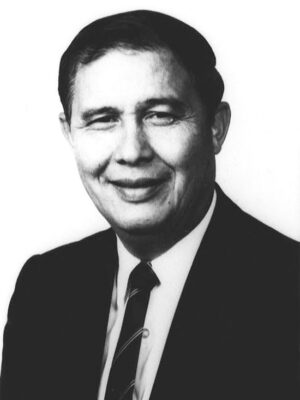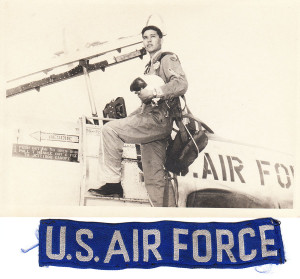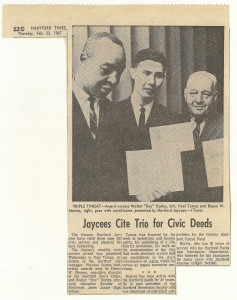Lt. Col. (Retired) Noel Tomas

Degree(s): BJ '59
Whereabouts: United States, Glastonbury, Connecticut
Lt. Col. Noel Tomas, BJ ’59, followed a self-created path to find inspiration and passion throughout his life. His years of service in four different military branches, multiple news outlets and public service gave Tomas experience in combat, communication and career training.
After high school, Tomas studied electrical engineering at Iowa State College in Ames, where his father had matriculated. During World War II, his father used his degree in organic chemistry to break down German powders and determine their composition to replicate them for U.S. weaponry. Unlike his father, the younger Tomas realized engineering wasn’t for him when he was confronted with a difficult calculus course.
At Iowa State, Tomas participated in the Naval ROTC program and even tried his hand at humor writing for the school’s publication, The Green Gander.
Having reached a standstill, Tomas decided to leave behind classrooms and notebooks to enlist in the U.S. Army, starting what would become lifelong involvement in not only the military but in service in general. Tomas would later return to humor writing while seeking a degree in journalism from the Missouri School of Journalism. He served in the U.S. Army and the U.S. Coast Guard before attending the Missouri School of Journalism.
A Diverse Background

When Tomas arrived in Missouri, he began his service in the U.S. Air Force Reserve, ultimately serving for 25 years.
In 1951, Tomas left Iowa State for a career in the military. He and other enlisted men went through basic training at the Signal School in Fort Gordon, Georgia, which included crawling under simulated machine gunfire, being gassed and crawling under barb wire in the mud.
After basic training, Tomas was shipped to the former Japanese Naval Academy in Tokyo, where a special Army field signal school occupied the former Academy’s buildings. There, he began learning radio teletype, a specialized means of communication using the then-latest high-speed teletypewriters, which required speed in coding and decoding groups of five-digit coded messages.
Tomas adapted well to the training at the signal school and became trained on the field mobile radio teletype, ANGR26ABLE, installed inside a 2 1/2-Ton truck, in which he translated up to 80 words per minute of coded digit groups. Upon completing this training, field assignments were posted. Tomas knew his signal corps training had ended when his superiors handed him an M1 with a battered butt plate, a clip with three bullets to fire to zero in his weapon and ordered him to a combat line company on the 38th Parallel in Korea in the 7th Infantry Division.
A lack of combat experience and the perils of war left Tomas feeling unprepared. A behind-the-lines unit captain summoned him from his line company. The captain noted Tomas had tried to enter West Point. The captain offered an Army appointment to West Point. Taking the appointment, he was flown stateside. While training at the Army’s West Point Prep School in Newburgh, New York, Tomas took two military academy exams. He successfully passed the West Point exam and completed the U.S. Coast Guard Academy’s entrance test. Turning down West Point, Tomas was notified by the Coast Guard Academy that they would accept him as a “Swab” in the freshman class.
For roughly eight months, Tomas went through introductory training at the U.S. Coast Guard Academy in Connecticut and learned about sailing, including on the USS Bark Eagle, a 200-foot, 4-masted sailing vessel berthed in New London, Connecticut. He eventually realized his passions didn’t lie in that branch of service. He resigned from the Coast Guard to take a job at General Foods, known later as General Mills, in Hoboken, New Jersey.
There, he tested the durability and shelf-life of products like Jell-O and Maxwell House Coffee but found himself remembering his enjoyment of writing humor pieces at The Green Gander. Tomas decided he was interested in journalism and the arts, specifically newspaper and magazine writing. In 1956, he was accepted as a junior to the Missouri School of Journalism so he quit his job at General Foods and left for Columbia.
Life as a Tiger
Tomas adjusted quickly to college life. Beyond journalism classes, he was granted junior-year status in the Advanced Air Force ROTC program at MU.
Tomas joined the satirical-humor magazine staff at ShowMe Magazine. The then dual editors – Skip and Nancy – noted his previous work at The Green Gander and encouraged him to consider becoming the next editor. ShowMe’s content consisted of articles, pin-up pictures, cartoons and other materials to initiate a humorous reaction from its audience while simultaneously addressing social and political issues. The magazine ceased publication in the mid-1960s. Tomas refers to some of the cartoons as “period sick humor.” One cartoon showed a youngster sliding down a stair banister headed toward the end that was a razor blade. It was drawn by Dick Noel who later worked for Hallmark cards.
The University of Missouri’s Board of Publications reviewed and censored any college-produced materials that might be deemed too inappropriate for publication. As the fourth issue was being distributed, they banned ShowMe outright, demanding that every issue be recovered from circulation and handed over for shredding.
“They said that night after the issues had been partially distributed, ‘Gather them or you’re going to be out,’ you know, inferring that they were going to put us on probation at school,” Tomas says. “I still kept a bunch.”
There were still plenty of opportunities for Tomas to get into hot water as a college journalist. He did some writing and a cartoon for The Maneater with his newly found free time. Tomas’s first piece played on the hero-worshipping culture around the football team, specifically how they acted at parties and used their brawn to force dates of fraternity members to dance with them. His editorial comments did not sit well with the football players.
The team’s anger was so great that, one day, they surrounded Neff Hall in an attempt to confront Tomas on his way to class. He realized the team’s gathering was occurring and remained unfazed, going through another door unnoticed. Having failed to intimidate Tomas at school, some members of the team broke into his apartment while he was out and attempted to ransack the place. Coincidentally, one of Tomas’s roommates, a former football player, found them and threw them out. Tomas says the threats stopped once the team realized their actions could result in criminal charges.

When he wasn’t studying or stirring things up, Tomas made extra spending money bartending at The Stable, an off-campus tavern in what was called the Hinkson. Weekends would find carloads of guys and coeds parked outside while the walls of the tavern – an old World War II mess hall – were removed so a band could blare out the latest hit music and bottles of beer could be obtained easily.
Early Career
After graduating with a bachelor’s degree from the Missouri School of Journalism and a 2nd Lieutenant Commission in the U.S. Air Force in 1959, Tomas married ShowMe colleague Janice Mosley, BJ ’59. The couple moved to Rolla, Missouri, when Tomas accepted his first post-college job as a writer for the St. James Journal.
From there, Tomas worked in Jefferson City for the Missouri Spectacular. He traveled around the state with Gerald Massie, a well-known photographer, to shoot scenery for the tourist magazine. After that, Tomas accepted a position at the Kansas City Star/Times (the morning paper).
Tomas simultaneously reported at the Times and also served in the U.S. Air Force Reserve as a career officer. The years of active duty included weekly meetings, often referred to as the “Little Red Schoolhouse.” The reserve unit Tomas served as the public information officer was one assigned to decontaminate aircraft that might have flown through a nuclear radioactive cloud.
“At the time there was a threat of nuclear war, particularly during the Kennedy years; we thought Russia would attack,” Tomas says.
At the Times, Tomas served as a general assignment reporter and photographer. He covered public projects, such as the urban renewal of the Kansas City, Kansas, downtown area and other city hall and Chamber of Commerce beats. He wrote obituaries (called the “glooms”) and arts and entertainment reviews.
This work introduced him to many officials involved in the city’s work, and he was offered a job as a public relations director in the Urban Renewal Agency. Their projects were not well received by the public, Tomas remembers, with many calling the works “urban removal.” He thus began a new chapter in his life, one that would be devoted to public service.
Public Service
Throughout his life, Tomas has been actively involved in public service and advocacy in local, state and federal levels of government and outside of these institutions. His first encounter with civil rights occurred after his wedding when he discovered anti-miscegenation laws made his marriage illegal in the state of Missouri. Tomas called the law outright discrimination and brought the issue to the highest authorities, including Missouri Gov. Warren Hearnes, U.S. Sen. Stuart Symington with a notice to the Philippine Embassy. His efforts were rewarded. The law was voided, and his marriage and children were legalized. Janice now lives in Texas.
But his career in activism had only just begun.

“You could describe me,” Tomas says, “not only as an advocate for the little guy, but as a provocateur for many causes.”
Tomas, as then chairman of the Hartford City Commission of Aging, led a “tea bag” revolt in Hartford, Connecticut. The revolt was a response to a sales tax increase, causing strain on older citizens who were on fixed or limited incomes. He used his journalism, public relations and marketing experience to spread the news of the revolt. The governor’s office called Tomas to inform him that citizens had flooded their office with actual tea bags and other less desirable materials.
Chairman Tomas worked with the Greater Hartford Council of Churches to initiate one of the first nutritional programs for the elderly in the New England states.
Tomas, as a senior U.S. Administration on Aging/Health, Education and Welfare representative also served on a national team of reviewers awarding the first federal government grants for the nation’s first hospice programs. He also led the nation with his testimony as the lead witness before the U.S. Senate’s Committee on Aging on crimes committed against older Americans, and other elder abuse. He was cited by U.S. Sen. Abraham Ribicoff in the Congressional Record for his work and writing on crimes against the aged.
And he was an active member of Hobart Jackson’s National Organization for the Black Aged, successfully helping get a White House release for Jackson for trespassing on the White House property.
With the 2015 controversy with Volkswagen vehicles cheating emission tests, Tomas had taken on the automative company when he bought a new Rabbit diesel. His car was the only vehicle shown for the nation’s first lemon law that first passed the Connecticut General Assembly unanimously. He appeared on Good Morning America and on CBS reporter Dan Rather’s shows with his lemon. Tomas recalled that the U.S. president of Volkswagen America resigned and the VW Rabbit model plant closed in Pennsylvania.
Tomas collects antique (1800s and earlier) hand-blown bottles. He started his collection of antique glass bottles in 1959, and it now numbers well over a few thousand pieces. Tomas launched the downeast GLASSMAN, a bi-monthly tabloid about glass collectors and collecting. He also wrote and took photographs for the Antiques and Arts Weekly as well as the Maine Antique Digest. Tomas currently serves as the president and chief operating officer at the Museum of Connecticut Glass Inc.
Coming Full Circle
In 2009, Tomas returned to MU for his 50th reunion and was amazed at how much the campus had changed in the years since his graduation.
One memory was of his role in the Missouri School of Journalism’s 50th anniversary in 1959. Tomas had taken photographs of notable guests attending MU’s Women in Journalism conference. One was of syndicated columnist Inez Robb, BJ ’24, talking to former first lady Eleanor Roosevelt. Robb used the photo on the full back page with byline of the New York World Telegram. She sent the tear sheet along with copies of the photo to Roosevelt for autographs, and then returned them to Tomas.
Tomas photographed the World Press Conference, the pinnacle of the School’s 50th anniversary celebration. Among more than 100 delegates from 35 countries was former President Harry S. Truman. Tomas stood apart from the working press photographers to take Truman’s picture upon his arrival.
“Harry didn’t look at all of the other press photographers at first; he looked straight at me with this toothy grin on his face, and he says, ‘Shoot, damn you, shoot’,” Tomas says. “I got the picture but I had never been cursed at by a president.”
Tomas has also photographed Richard Nixon, Jimmy Carter and columnist Ann Landers. He also earned an Executive Master’s of Business Administration from the University of New Haven in Connecticut.
Tomas has been recognized for his military service. In 2015, the Connecticut Chapter of the Korean-American Charity Foundation was awarded him the Korean government’s Peace Keepers Medal. In his keynote remarks, he urged the audience to remember that the Korean conflict is not “a forgotten war.” The state of Connecticut also awarded Tomas a medal for his war service.
Commitment to the First Amendment is a firm belief for Tomas. Instant communication methods, Tomas says, mean journalists will need to evolve in this all-electronic age to “report important stories to keep the people free from those who would destroy those freedoms to think, to act, to associate and to speak and hear the truth.”

Abigail Uhlar is a senior from the Chicagoland area. She is studying strategic communication at the Missouri School of Journalism and minoring in business. Uhlar has taken courses in public relations, marketing and media to supplement her interests in social media, research and branding. After graduation, she plans to move back to Chicago to work in the public relations or marketing field.
Updated: January 13, 2020